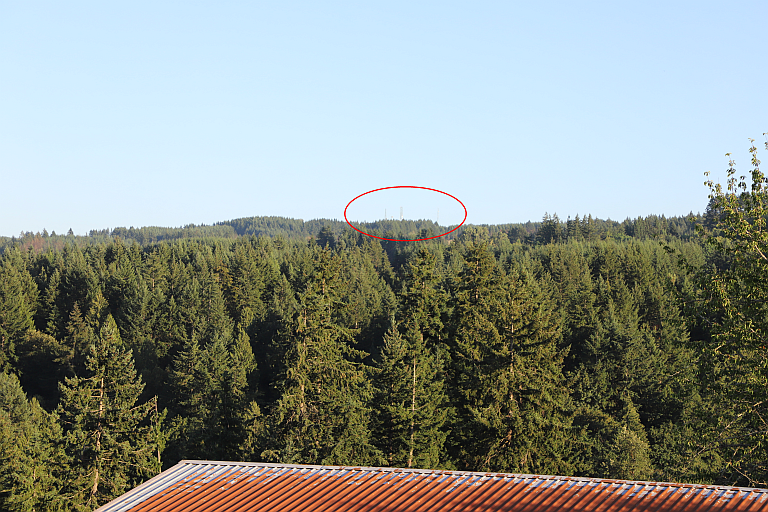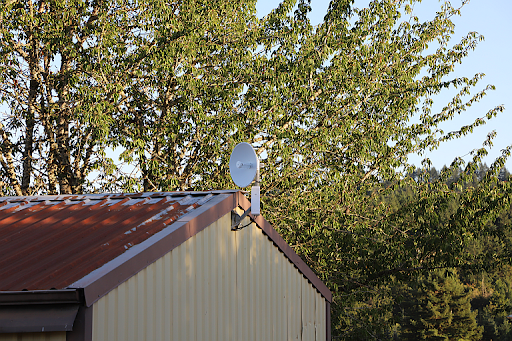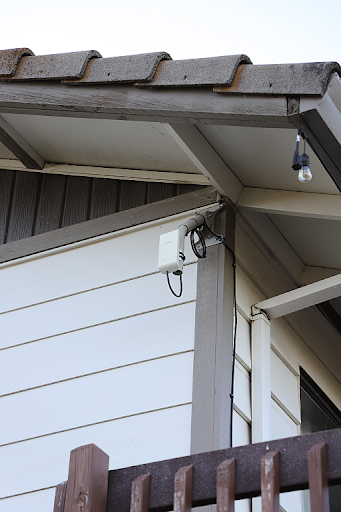Introduction: A friend of mine recently moved to the suburbs and found that distance from the city is inversely proportional to progress. Here is his firsthand dispatch, smuggled out of suburban Portland, Oregon, barely 15 miles from Intel. If a cell tower falls in the forest and there’s no one there to hear it…
This is a case study in internet (un)availability in places deemed inconvenient for service providers. Internet connectivity used to be something of a luxury, part of what you sacrificed if you wanted to move out to the countryside, beyond a major metropolitan area. The reality, however, is that most people don’t actually make that choice. More often, the people are already there, and the internet just never comes.
That the US internet infrastructure focuses on low-hanging fruit is not news. And there may be some developments that will ease it. But this specific story illustrates how frustrating it can be today, and the fact that, in reality, nobody in charge cares. Even though we’ve entered an age where the internet is a basic necessity like electricity or running water, you’ll get no sympathy from the providers (and little from the government, whether municipal, state, or federal).
I also include here some details from my interactions. They illustrate some of the… let’s call them microaggressions. It’s amazing how much time you can waste talking to people who really don’t seem to care, even if their customer service script has things on it that are supposed to sound warmly empathetic.
Moving On Up
This story starts with a house move. Before buying the house, I was in a rental property that had no cell service whatsoever, and the DSL was flaky and unreliable. I couldn’t work from home, so I needed to rent an office in town.
One of the key criteria for the new place was the ability to work at home, which means adequate, reliable internet of some sort. Good cell service would be nice, too, but good internet would allow Wi-Fi calling to pick up the slack. Internet connectivity was right at the top of the house-hunting wish list.
The connection would have to support online meetings and online college courses, possibly with simultaneous TV streaming. None of that demands extraordinary bandwidth, but it does need at least 15 Mbps or so, which doesn’t even qualify as “broadband” under the FCC’s guidelines (defined as 25 Mbps and up).
The previous owners of the property we bought said they had internet speeds of 25 Mbps through a service from… let’s call them U-Stationary. The previous homeowner had worked from home (at least some of the time) for a big semiconductor company in the area. Plus, he was a gamer. You can’t do that on chintzy internet. We figured we’re fine.
Before moving in, I went to sign up with U-Stationary. I didn’t know their specific plan names, so I just went to the U-Stationary retail store and got an access point. It rented for a reasonable monthly price, which included a data cap of 100 GB. I had no idea how much data I would need, but 100 GB per month sounded like a lot. So, knowing that this setup had worked for previous owners, I went forward.
The access point is a little credit-card-sized box that contains both cellular and Wi-Fi transceivers. Cellular data in, Wi-Fi signal out. It was relatively easy to get working, but the Wi-Fi signal was very weak and didn’t cover the whole house. So, I bought a Wi-Fi extender, and that fixed that problem.
But the bandwidth was extremely volatile, ranging from excellent down to paltry. It was hard to predict the timing, but it could get as low as 1.5 Mbps. Strangely, the upload speed at that same time might be 20 Mbps. This asymmetry is the opposite of what most users experience but was typical for this connection. So, I wanted to get another extender, this time to improve the cellular signal, and thus, the bandwidth.
I called the company and waited 45 minutes for a call back (since the queue was long). I then spent 45 minutes explaining to someone what the issue was. She said I needed a mini-tower. Remarkably, it arrived the very next day.
The installation instructions said I needed to connect it to… Ethernet. What Ethernet? Reading further, it says the mini-tower must be connected to a source of internet. This wasn’t what I thought it was. This was for installations with a weak cell signal but a strong internet connection. It then acts as a cellular booster in the house.
I called back, and they agreed that they’d recommended the wrong equipment. What I needed was an extender. Except for one problem: the company had discontinued their extenders. It wasn’t clear why they would intentionally reduce their potential customer base, but that was that. They had no good options. Cue shoulder shrug.
I got put on hold for a while, and someone new came on. I had to start all over and completely re-explain the whole situation, and the new person agreed that there was no solution. Naturally, the money-back “buyer’s remorse” period had just ended, but my new friend made a note to refund the purchase price of the equipment if I canceled the service.
It was time to explore other options.
Let’s Start Seeing Other People
I tried the other obvious names. The Verizon store checked my address for coverage, which was listed as good. But I didn’t qualify for their internet service because there wasn’t enough spare capacity on the tower. So, they had no available solution. In spite of this, I still get repeat emails encouraging me to complete the sign-up process I’d previously abandoned, a classic example of tone-deaf communications from a communications company.
Next door at the AT&T store, they also confirmed that my coverage was adequate. But I needed an AT&T phone account to do anything at all, which I don’t have. The AT&T representative suggested I try Cricket Wireless, which AT&T owns, and which happens to already be my cellular provider. He cautioned me, however, that Cricket signals are sent at 30% of the power of full-on AT&T signals. Since I was getting 2–3 bars on my phone, I figured that would probably be okay. But I decided to explore AT&T-branded service first.
They have a couple of residential plans, but even the most generous plan has a data cap of just 35 GB per month. That’s nothing; I’d use that up in a week. So, the person I was talking with needed to put me on hold to consult with someone else.
After a bit of a hold, some automated system comes back onto the line and asks for my account number. Of course, I don’t have one yet, but that’s not an acceptable answer to this bot. It can’t understand, “I don’t have an account,” and keeps insisting on a number, until finally it transfers me… somewhere.
Turns out I was sent to the “loyalty group,” not the cell-service group. Friendly guy on the phone, and he can talk to me about plans, but he can’t sell me anything. I hear all the details about their residential plans, but they’re all inadequate. He suggests a business plan, and transfers me there, cautioning that they’re probably closed for the day. They weren’t.
Before transferring me, he gives me a direct number to call in case I get blocked by the phone system again. I decide to call that number instead. I struggle with a new automated agent, get to a person, get transferred again, and finally can talk to someone about business plans. All of which are wholly inadequate. And expensive. They consider 8 Mbps to be “high-speed internet.” Regardless of price, that won’t work for me.
Cricket doesn’t seem to have any business plans whatsoever, so that left me with no other cellular carriers to try out. Next step: try to see if there’s any way to salvage the U-Stationary installation I was still limping along with.
The Dreaded Band 71 (Band on the Run)
Since they didn’t offer their own extenders anymore, I looked into third-party extenders. Turns out, there are a number of them, some universal and some customized for a particular wireless carrier. The latter seemed to offer better performance and easier setup, so I had my eye on one of those.
But there’s a catch. There are a number of frequency bands in use for cellular systems, but I was nervous about so-called “band 71” at 600 MHz. (As an engineer, at least I could understand what was going on while researching this stuff, something that would have been a lot harder for a nontechnical user).
Band 71 is often used for rural coverage, since the lower frequency gives it longer range. But that band was previously used for broadcast TV, and, while that’s not true anymore, the FCC has yet to approve extenders for that frequency range. Which raises the possibility that any extender I buy would amplify all the signals except the one I wanted. Still, we’re located close enough to civilization that I hoped we’d be OK.
I got on the phone again with tech support. The technician confirmed that, yes, our service uses band 71. He then transferred me to a specialist group. It was a two-hour wait, so I scheduled a call back, which came after an hour. And then I waited on hold some more.
The person who answered suggested I start by resetting the access point (not just rebooting, which I had done several times before). Fortunately, I was calling him on a different phone using another wireless carrier, not my usual Wi-Fi calling over internet. Otherwise, resetting the access point would’ve killed the connection and I would have had to get back into the support queue all over again.
After the reset, we were still getting only about half the speed we’d had when we’d first signed up (it’s that flaky variability thing). So the customer service person said she’d send an engineer to the tower to make sure everything was okay there. We should see improvement in around three days. Maybe.
“Not Available in Your Location”
While awaiting that, I contacted the previous owners of our property. They sent me a picture of the device they’d used, which was different from the device I had. So, I went back to the store to say, “Here’s the thing I want.” Turns out, it’s part of a new-ish program that’s not available in their retail stores. You have to order it online. The guy in the store tried to set me up online, but it failed every time he hit the “submit” button. Even trying different computers all gave the same result.
I went back home and called them, and was told that the program wasn’t available in my area. I explained that the previous owners at this address had already used it successfully (I’m assuming here that they were telling me the truth), but got the corporate shoulder shrug. No, we can’t look back at any other accounts; the answer is just No. Go away. He transferred me to tech support.
There’s something particularly sadistic about this company’s music-on-hold. The music itself is bad enough, but every so often there’s a break – and your heart leaps, thinking, “Aha, finally!” … and the music restarts. This happened many times. Horrible way to treat customers.
I started wondering whether maybe I’d been dumped onto an automated support line that goes nowhere, but after half an hour of nothing but the music, I finally get the dreaded “All agents are busy helping blah blah” message. Okay, so at least maybe this is a live line.
I give up after an hour and a quarter, almost all of which was spent on hold. I called back in the evening, hoping the queue might be shorter. That time, I waited on hold for 19 minutes, but when someone finally answered, it wasn’t the right group. They transferred me, promising me queue priority.
The next guy said that the cell signal simply wasn’t strong enough where I was. Never mind that the previous owners had used it just fine. “Things change,” he explained. Really? That’s how your service works? You can have broadband one day, and a few days later it’s gone? And that’s just how it goes?
He also said there were more bands in use than just band 71, but that it wouldn’t matter. Because of the weak signal, all the packets get lost on the way, he said. And a booster wouldn’t help. I’d get more bars, but there was no way to recover the packets that… what?… dropped out of the sky onto the ground below?
That’s not how it works, and it was concerning that these were the technical support folks telling me this. Packets don’t just drop away. They’re always there; it’s just a question of whether you can recover them from a weak signal. Boosting the signal does exactly that. But try explaining that to a dude who’s pretty sure he’s a technical wizard. (As Scott Adams said once, “Now you’re… confessing your inadequacies to a stranger whose best career option is a job in technical support.”)
As to signal strength, band 71 is supposed to have a range of about 30 km. I can see the tower through my window and it’s barely 5 km away, with a direct line of sight. Not so much as a tree in the way. Signal strength should not be an issue.

Figure 1: Cell towers approximately 5 km away, with a clear line of sight.
But technical arguments get set aside by the salient fact that, bureaucratically, someone has to decide whether to offer the plan I wanted. Even if all the technical specs were great, someone could still say “No,” and that would be the end of it. In fact, that was the end of it. Never mind that this same house qualified a few weeks ago.
So I asked to speak to a supervisor, since none of this seemed to pass common-sense muster. I was literally pleading: we had plunked down serious money on a property that supposedly had good internet, and now it didn’t, and no one cared a whit. I needed to escalate.
I went on hold for a while. The guy came back and apologized for the hold time and said they’d be back shortly. Waited. And waited. And then… click! Disconnected. Yeah, that happens, and that’s why they ask you for a call-back number early on. But there was no call back. They were clearly tired of dealing with an annoying #%@# customer. That was the end of the line trying to get anything out of them. Whatever was available to the guys before us was not going to be made available to us. Period. Go away.
Last-Gasp Extender
There was one odd little detail that caught my attention during the various discussions and digressions. While band 71 was part of what we were receiving, they mentioned using it for 5G coverage. Now, I don’t care about 5G, even though I know that everyone else is busy giving people that already have perfectly good service even better service. I just want the basic good service. 4G LTE is fine. If band 71 is carrying 5G stuff, no problem. But that might mean that the 4G LTE service is being carried on one of the other bands.
So, I decided to get one of those third-party cellular extenders. It’s $600, but it had a 60-day return policy, which is long enough to give it a good shot. I ordered one, and it got here very quickly. After hooking it up (not hard), I found that the bandwidth still varied all over the place. Since that’s what had already been happening, it was hard to tell if the extender was making any difference.
Then disaster struck. Remember that 100 GB data cap? We hit it two days before the end of the month. The company calls it “throttling,” but it might as well be turning out the lights completely. Speeds dropped to 10 kbps – way slower than even dial-up. That’s no internet at all. We had to go connection-free for a couple of days.
Having learned that this data cap was too low, there was no way that U-Stationary’s service was going to work for us, even if the technical problems got solved. I had to start looking again at other carriers.
I called Verizon again. Their best business account offered 50 Gbps with a 125 GB data cap, for $200. Home internet isn’t available.
I checked AT&T again. They have a business plan, but it doesn’t allow access to consumer applications like entertainment. Home internet isn’t available.
Cricket doesn’t look like they have business plans at all. That’s not really their thing. They have a mobile hot spot, but that’s all.
So I then called a local fixed-wireless company. They’re known for being somewhat expensive, so I hadn’t really looked into them before, but at this point, I was willing to pay almost anything. (Or at least, anything less than the cost of renting an office in the city and setting up internet service there.) They didn’t answer their phone, but the prerecorded greeting said to leave a message after the beep – and then disconnected the line before you could.
I tried contacting them by email, and got a response. They need an unobstructed line of sight to the tower; no trees can be in the way. But this is Oregon. We have trees, and lots of them. So, they had to send someone out to examine the site before deciding whether their service would work.

Figure 2: The main receiver dish on the barn. It has a direct line of sight, while the house does not. The small vertical rectangle below the dish is the relay antenna.
While I waited for them, the data cap got reset, and we were getting 41 Mbps! Much better than before. Maybe the new cellular extender was working after all! So, here’s the choice we had: stick with the current cellular service with their higher speed but a nasty data cap, or switch to fixed wireless with a lower (but consistent) speed and no data cap.
After more testing, however, I was less convinced that the extender was doing anything, so I decided to go ahead with the fixed-wireless option. I’d keep both services going for a while until we knew which one would win.
The guy came out, and sure enough, there was a tree directly in the path of the signal to the house. No go. Ah, but there is a barn on the property, and it has a clear signal path. They could put their main antenna there and then do a private relay over to the house. That would take more equipment than he’d brought with him, so the installation was rescheduled for the following week. On the plus side, he did find a good signal (60 dBm), with aggregate bandwidth of 50+ Mbps, of which we’d get 15 Mbps.
One week and $500 later, the installation went smoothly, and we actually ended up with 20 Mbps. And no data cap. I discontinued the U-Stationary service a month later. I couldn’t get any money back for the equipment I’d bought, so I’ll just consider that sunk cost. I was able to return the extender and get my $600 back, though.

Figure 3: The relay antenna at the house
Meanwhile, In the Woods…
Right before all of this happened, we spent a weekend at a remote cabin on the north shore of the Columbia River in Washington, far from anything. And it had… fiber. Fricking fiber, in the middle of nowhere. Even undeveloped lots had a pedestal ready to go. I asked how that happened, and the owner said a community group got together and did their own network.
So… out in the wild, folks have fiber for their vacation homes, while, 15 miles from Intel’s main plant, I can’t get jack.
There’s also traditional satellite. This uses geostationary satellites, which orbit at very high altitude, giving really bad latency. And it’s an unforgiving contract. A neighbor described hooking up the satellite equipment and getting… nothing. But the two-year contract cost many, many hundreds of dollars to undo. That was not a direction I was willing to even investigate.
Starlink is an interesting possibility in the future. I’m a bit nervous about signing onto a service with attractive start-up terms that might change later, especially when the company is run by a CEO with a mercurial nature and a notorious “I do what I want” mentality. What we have now is working (albeit for $200/month), so we’re sticking with it. I might explore Starlink once it settles out. Beta feedback reports about lots of outage periods as they sort things out, and I’m not up for that. Maybe when it’s stable.
Somewhere along the way, I tried to contact the local government folks who deal with communications. Their phones all said to leave a message, so I did, but no one ever called back. In hindsight, it may have been a tactical error to mention that I was trying to get access to more remote places.
Then I participated in a webinar with the FCC commissioner to hear what he had to say about improving access. I submitted a question outlining our situation and asking what could change. Granted, my question was probably too wordy, but the handlers chopped it up so much that what he got was a softball question that he could answer by saying that fixed wireless would be a better solution than laying more fiber. Next question.
This story has a happy-enough ending. But it almost didn’t. And we were lucky to have a fixed-wireless carrier in the area. I’d spent a month extremely stressed out, thinking I’d made a great property purchase that turned out to miss one of the key must-haves. Would I have to sell up and move? Rent an office? Would we have to accept life without real internet? (Our neighbor, who has lots of trees, has zero internet options.)
The main thing I learned is that no one cares. The service providers are busy servicing low-hanging fruit, and my problems are simply my problems, not their problems. Government folks just want to give easy answers or avoid the situation entirely.
It feels like we’re a long, long way from addressing this part of the internet divide (as opposed to the part where people have access, but can’t afford it). Yeah, new money is being debated in budgets, but I’m not holding my breath.





